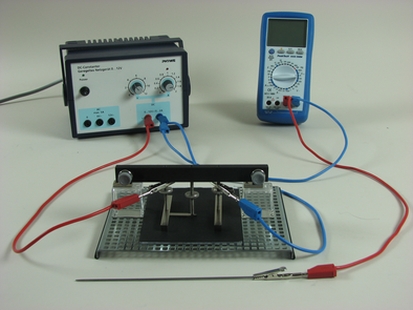Principle
A lightning forms a strong electric current, which is created, when in a medium (for example air) a large number of free charges is produced by strong electric fields. During a thunderstorm usually high elevations from earth (for example skyscrapers) are more often affected by lightning strokes.
Investigate how the electric field between a thundercloud and the earth ground is distributed in the area next to a skyscraper. Consider the thundercloud and the ground as parallel electrodes. Simulating a high building one of the electrodes will be configured with a sharp elevation.
Benefits
- No electrolyte required
- Direct measurement of potential with high resistance voltmeter
- Measuring points can be transferred (pressed through) onto a sheet of white paper during measurement
Tasks
- Measure the distribution of the potential within the electric field and derive the electric field pattern.
- Observe how the electric field changes in the area of the tip electrode and transfer your observations to the situation of a thunderstorm.
Learning objectives
With this experiment the students will investigate how a lightning is created during a thunderstorm and why elevations from the earth such as skyscrapers have a higher risk of being struck. In the experiment the students will simulate the electric field between a thundercloud and the earth ground by two parallel rod electrodes. One of the electrodes contains a tip-shape electrode, which changes the homogeneous electric field the same way a skyscraper will change the field between thundercloud and earth ground.



